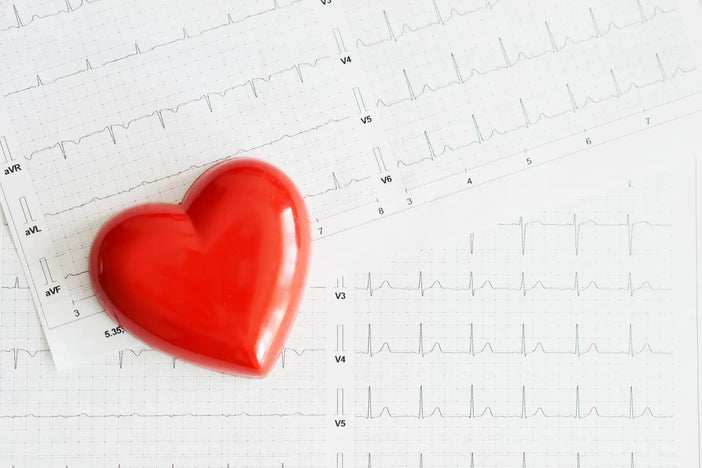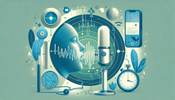High Blood Pressure Education Month: the impacts on type 2's and 6 ways to decrease hypertension

May is High Blood Pressure Education Month. Under American Heart Association guidelines, nearly half of U.S. adults have high blood pressure and 75% of those with high blood pressure do not have it controlled. This means there is more work to do to help American adults understand their numbers and risks of this “silent killer.” So what is blood pressure, how does high blood pressure impact your type 2 diabetes, and how can you control hypertension and improve your cardiovascular health?
What is blood pressure?
Blood pressure is the pressure your heart uses to push blood through your blood vessels and around your body. There are two numbers used to describe blood pressure and it’s measured in millimetres of mercury (mmHg). It’s written like this: 130/80mmHg. And you’ll hear your doctor say '130 over 80'.
The first number is the systolic pressure. This is the most amount of pressure your heart uses when beating to push the blood around your body. The second number is the diastolic pressure. This is the least amount of pressure your heart uses when it is relaxed between beats. Using 130/80mmHg as an example, the systolic pressure here is 130mmHg and the diastolic pressure is 80mmHg.
If your blood pressure is high (called hypertension), you’ll need treatment to bring it down. This is because it puts a strain on your blood vessels and can damage them. This can make it harder for blood to flow around the body and reach all the vital areas it needs to, like your heart. And you’re more at risk of having a heart attack or stroke.
High Blood Pressure and Type 2
Having high blood pressure also puts you more at risk of developing all types of diabetes complications, like serious problems with your feet, your eyes and your kidneys. “Blood pressure should be below 140/80mmHg for people with diabetes... But it is important to speak to your healthcare team about your individual target.” People with diabetes and high blood pressure are more at risk of having a heart attack or stroke. So it's important to know how to look after your blood pressure, says Diabetes U.K.
6 Ways Decrease Hypertension
- Get Checked Routinely - You might not have visible symptoms so you must check your blood pressure on your own or at your doctors routinely.
- Quit Smoking - Smoking increases your heart rate, and increases the likelihood of blood clots. There are many ways to quit smoking or eliminate second hand smoke from your life. Some top tips are eliminating triggers, joining a support group, temporarily using a nicotine replacement system and keeping a journal. Read more about smoking and type 2 on our blog.
- Limit Alcohol - Drinking alcohol can cause your blood vessels to become more narrow and causes your heart to have to work harder to push the blood throughout your body. The Mayo Clinic states that, “Heavy drinkers who cut back to moderate drinking can lower their top number in a blood pressure reading (systolic pressure) by about 5.5 millimeters of mercury (mm Hg) and their bottom number (diastolic pressure) by about 4 mm Hg.” Keep in mind that alcohol also has a lot of calories which can also cause weight gain or make it difficult to lose weight (which also impacts type 2 and hypertension). Find out more about alcohol and diabetes on our blog.
- Limit Salt Intake - The excess water your body holds onto when you eat salt increases your blood volume, making your heart work harder. Use sodium-free spices or flavorings with your food instead of salt, and buy foods labeled "no salt added," "sodium-free," "low sodium" or "very low sodium". Remember that when you order in or go out to eat, you can’t necessarily control the ingredients. Therefore you may have excess salt, oils and sugars in your food. Plan your meals at home and do this according to recommended servings of healthy grains, vegetables, fruits, dairy and lean meats.
- Self Monitor Your Health - keep an exercise, food or blood pressure log! Planning your workouts each week and recording them can help you track your progress, whether it is a step goal (such as 10,000 steps per day) or an amount of time you want to elevate your heart rate (such as 150 active minutes a week). Record your blood pressure when you self check or go to the doctor.
- Take Medications as Directed - Simple lifestyle changes like the above can lower your blood pressure to healthy levels and help you maintain a healthy life with type 2 diabetes. However, if medication is recommended, take it regularly and keep honest and open communication with your doctor. If you do get side effects, do not stop taking your medicine. Talk to your doctor, who may advise changing your medicine.
Try connecting with other diabetics who are focusing on decreasing hypertension in the Winning Type 2 Diabetes Together community on Facebook. Here, you’ll find tips, opportunities to connect, and a sense of belonging. Get the support and information you need by joining our Winning Type 2 Diabetes Together community.



